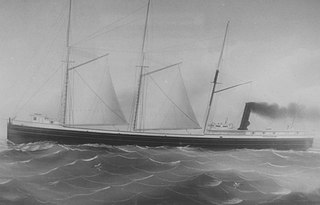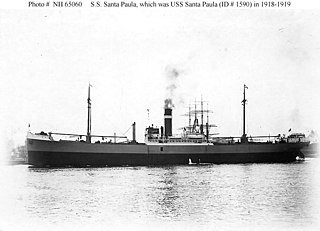Related Research Articles

The PS Lady Elgin was a wooden-hulled sidewheel steamship that sank in Lake Michigan off the fledgling town of Port Clinton, Illinois, whose geography is now divided between Highland Park and Highwood, Illinois, after she was rammed in a gale by the schooner Augusta in the early hours of September 8, 1860. The passenger manifest was lost with the collision, but the sinking of Lady Elgin resulted in the loss of about 300 lives in what was called "one of the greatest marine horrors on record". Four years after the disaster, a new rule required sailing vessels to carry running lights. The Lady Elgin disaster remains the greatest loss of life on open water in the history of the Great Lakes.

SS Andrea Doria was a luxury transatlantic ocean liner of the Italian Line, put into service in 1953. She is widely known from the extensive media coverage of her sinking in 1956, which included the remarkably successful rescue of 1,660 of her 1,706 passengers and crew.

RMS Empress of Ireland was a British-built ocean liner that sank near the mouth of the Saint Lawrence River in Canada following a collision in thick fog with the Norwegian collier Storstad in the early hours of 29 May 1914. Although the ship was equipped with watertight compartments and, in the aftermath of the Titanic disaster two years earlier, carried more than enough lifeboats for all aboard, she foundered in only 14 minutes. Of the 1,477 people on board, 1,012 died, making it the worst peacetime maritime disaster in Canadian history.

HMS Royal George was a ship of the line of the Royal Navy. A first-rate with 100 guns on three decks, she was the largest warship in the world at the time of her launch on 18 February 1756. Construction at Woolwich Dockyard had taken ten years.

Endurance was the three-masted barquentine in which Sir Ernest Shackleton and a crew of 27 men sailed for the Antarctic on the 1914–1917 Imperial Trans-Antarctic Expedition. The ship, originally named Polaris, was built at Framnæs shipyard and launched in 1912 from Sandefjord in Norway. When one of her commissioners, the Belgian Gerlache, went bankrupt, the remaining one sold the ship for less than the shipyard had charged – but as Lars Christensen was the owner of Polaris, there was no hardship involved. The ship was bought by Shackleton in January 1914 for the expedition, which would be her first voyage. A year later, she became trapped in pack ice and finally sank in the Weddell Sea off Antarctica on 21 November 1915. All of the crew survived her sinking and were eventually rescued in 1916 after using the ship's boats to travel to Elephant Island and Shackleton, the ship's captain Frank Worsley, and four others made a voyage to seek help.

Grace Dieu was the flagship of King Henry V of England and one of the largest ships of her time. Launched in 1418, she sailed on only one voyage and was subsequently laid up at anchor in the River Hamble. She burned in 1439 after being struck by lightning. The wreck is a Protected Wreck managed by Historic England.

SS Henry B. Smith was a steel-hulled lake freighter built in 1906 by the American Ship Building Company at Lorain, Ohio USA. The steamship was owned by the Acme Transit Company of Lorain, Ohio, under the management of William A. Hawgood. The hull number was 343 and the registration number was US203143.

The SS Mohegan was a steamer which sank off the coast of the Lizard Peninsula, Cornwall, on her second voyage. She hit The Manacles on 14 October 1898 with the loss of 106 out of 197 on board.
Wreck Alley is an area a few miles off the coast of Mission Beach, San Diego, California with several ships intentionally sunk as artificial reefs and as Scuba diving attractions for wreck divers.

The John M. Osborn was a wooden steam barge that sank in Lake Superior in 1884 with the loss of five lives. The Osborn was just 2 years old when the larger, steel-hulled Alberta, which was called a "steel monster" and "terror of the lakes", rammed her. The wreck of the Osborn was discovered 100 years after her sinking. The wreck was illegally salvaged in the 1980s. Many of Osborn's artifacts became the property of the State of Michigan after they were seized from Great Lakes Shipwreck Museum. The State allows the museum to display the artifacts as a loan. The wreck of the Osborn is now protected by the Whitefish Point Underwater Preserve as part of an underwater museum.
SS Norwich City was a British cargo steamship. She was built in 1911 as Normanby, and renamed Norwich City in 1919. She was wrecked in the Pacific Ocean in 1929. For many years her wreck was a sea mark on the atoll of Nikumaroro. The wreck is now largely broken up.

Alf was a three-masted Norwegian barque which became stranded and then wrecked on 23 November 1909 on Haisbro Sands, off the coast of Norfolk. She was originally built in 1876 as Inchgreen for Scottish owners. In the 1890s she was sold to Danish owners and renamed Adolph Harboe. Around the turn of the 20th century she was sold to Norwegian owners and renamed Alf, serving until she was wrecked off the coast of Norfolk.

SS Port Nicholson was a British refrigerated cargo ship owned by the Port Line. She entered service shortly after the First World War and was sunk by a German U-boat in the Second World War. Her wreck has subsequently been discovered, attracting attention with claims that she was carrying a large cargo of platinum ingots and other precious metals when she was sunk.

SS Santa Paula was a freighter of the Grace Line and later the American-Hawaiian Steamship Company. The vessel also saw military transport service during both World Wars.

RNLB Foresters Centenary is a retired Liverpool-class lifeboat of the Royal National Lifeboat Institution (RNLI), stationed in the English coastal town of Sheringham in the county of Norfolk in the United Kingdom. The lifeboat was on station for 25 years between 1936 and 1961 when she was sold. She has been restored to her original condition and is exhibited in Sheringham Museum.

The SS Schomberg was a clipper built in Aberdeen by Alexander Hall & Co. for "the Black Ball line" for carrying large cargoes and steerage passengers, and to "outdo the Americans". When built, she was regarded as the most luxurious and well-built clipper of the period.
SS Monagas was a Venezuelan tanker that was torpedoed by the German submarine U-502 in the Gulf of Venezuela 12 nautical miles (22 km) west of Punta Macolla on 16 February 1942 while she was travelling from Maracaibo, Venezuela to Aruba while carrying a cargo of oil products.

Gunilda was a steel-hulled Scottish-built steam yacht in service between her construction in 1897 and her sinking in Lake Superior in 1911. Built in 1897 in Leith, Scotland by Ramage & Ferguson for J. M. or A. R. & J. M. Sladen, and became owned by F. W. Sykes in 1898; her first and second owners were all from England. In 1901, Gunilda was chartered by a member of the New York Yacht Club, sailing across the Atlantic Ocean with a complement of 25 crewmen. In 1903, she was purchased by oil baron William L. Harkness of Cleveland, Ohio, a member of the New York Yacht Club; she ended up becoming the club's flagship. Under Harkness' ownership, Gunilda visited many parts of the world, including the Caribbean, and beginning in 1910, the Great Lakes.

The Nettle was a 19th-century Sandy Hook pilot boat built in 1844 by S. Hall of East Boston, Massachusetts for the New York Pilots. She helped transport maritime pilots between inbound or outbound ships coming into the New York Harbor. In 1868, she found the wreck of the bark Henry Trowbridge, and towed her to Sandy Hook. The Nettle, sank in 1876 in the Pensacola Bay. The sunken wreck was removed in 1878 to improve the Pensacola harbor.

SS John Mitchell was a steel-hulled, American lake freighter in service between 1907 and 1911. She was built in 1906 by the Great Lakes Engineering Works in St. Clair, Michigan, for the Cornell Steamship Company of Chicago, Illinois, which was managed by C.W. Elphicke. She entered service in 1907, and had a sister ship named William B. Davock. Throughout her career, John Mitchell carried iron ore and coal. On October 4, 1908, she ran aground at Indiana Harbor, Indiana, while loaded with iron ore.